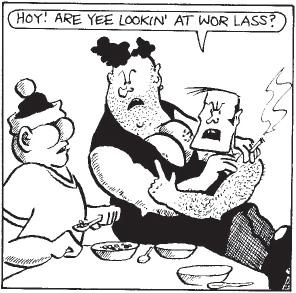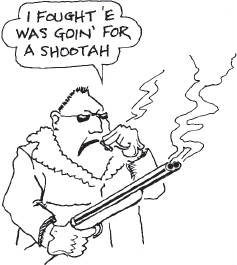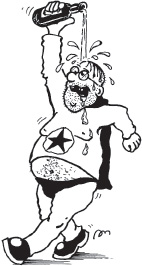
Полная версия
The Inside Story of Viz: Rude Kids
Over a year the Foundation course sorted the wheat from the chaff. By the end of it the wankers had become hardened art students, destined to have failed pop careers and eventually work in advertising, while dismayed and disillusioned individuals like myself, who were happy with their natural hair colour and preferred Gloria Jones’s version of ‘Tainted Love’, found ourselves back at square one. My parting advice from the senior graphics lecturer, Dave, was that I should get away from this dirty old town, quit Newcastle and head for the bright lights and the big opportunities. He said I should go to Exeter. Apparently Exeter University had an illustration course where I could hone my cartooning talents and qualify to become a greetings card illustrator. If there was one thing I hated it was ‘humorous’ greetings cards. If anyone ever sent me one it went straight in the fucking bin. So I ignored Dave’s advice and decided that my next career move would be to sign on the dole again. Throughout my spell at college I’d continued to publish Viz, but my graphic design work had really started to take off. I’d had one major job to do, designing a clothing catalogue, and this meant working late at night, often all night, trying to cram in other jobs for my regular customers too, then going to college the next day feeling like shit. One morning I actually went to bed for ten minutes thinking it would make me feel a bit brighter when I got up, but it didn’t. Viz No. 6 came out just before I started college, in July 1981, and featured my new creation, Roger Mellie the Man on the Telly. I based his director Tom, the straight man, on my recollection of Something Else producer Gavin Dutton. But a far more popular character launched in the same issue was Billy Britain, a patriotic, right-wing racist who had the catchphrase, ‘What a glorious nation’. The sort of person I’d imagine subscribes to This England magazine. Initially Billy Britain was a much bigger hit with readers than Roger Mellie, but a fatal design flaw would limit his long-term potential. His face was too complicated. I just got lucky the first time I drew it, in the title frame, but subsequent attempts to reproduce the same face weren’t so good. I could only draw him from one angle and with one facial expression, which drastically limited the scope for character development. Roger Mellie, on the other hand, and Norman the Doorman who also made his debut in issue No. 6, were much better thought out. Their simple designs took into account the fact that I was, at very best, a rather mediocre cartoonist. Norman the Doorman was based on the gorillas whose job it was to uphold the ridiculous dress codes imposed by licensees in Newcastle city centre. No white socks, for example. It was also one of those strips where the name came first. You’d think of a name and it sounded so good you simply had to follow it through and come up with a cartoon to match.

Billy Britain
When issue No. 7 appeared in December 1981 it featured the first appearance of Biffa Bacon. Biffa’s name, kneecaps and elbows were undeniably inspired by the Dandy’s Bully Beef, but his character and relationship with his parents, Mutha and Fatha Bacon, were inspired by an incident I witnessed on a Metro train in Newcastle. Two young kids, aged seven or eight, had started squabbling in the aisle of a crowded train and were pushing and shoving each other. Their respective fathers were sitting on opposite sides of the carriage and you’d have expected them to intervene. But instead of reining his son in and telling him to behave, the heavily tattooed father sitting closest to me leaned forward and whispered in his son’s ear, ‘Go on, son, I’m right behind you.’ From that sprang the simple idea of a bully whose father eggs him on rather than spanking him with a slipper. In fact his parents are more violent than he is. Issue 7 also featured a significant strip by Simon called the Lager Lads. This was inspired by a series of what seemed to us unlikely TV commercials for McEwan’s lager in which three young lads went into pubs – laughing, smiling and drinking McEwan’s lager – and never once got pissed or glassed anyone. The Lager Lads was the forerunner of Sid the Sexist.

Biffa, Mutha and Fatha Bacon
With a TV appearance in the pipeline I’d boldly ordered 2000 copies of No. 6, double the previous print run, at a unit cost of just over 11p, and I stuck with 2000 for issue No. 7. By 1981 the comic was reaching cult status among the student population of Newcastle, and sales in city centre shops were taking off. Brian at the Kard Bar was ordering an initial 500 copies of each issue, on condition that he had the comic at least a week before any other shops. By now I’d talked Virgin Records into stocking Viz, and HMV followed suit not long afterwards. Volume (formerly Listen Ear), Virgin and HMV were now all ordering fifty copies on an almost weekly basis. On the one hand this meant I could now retire from hawking the comic around the pubs, but it also posed one or two logistical problems. I couldn’t drive and I had no car, so all the deliveries had to be done on foot and by bus. On at least one occasion Simon and I pressed two of my granny’s ‘Mrs Brady’ style shopping trolleys into service to deliver comics to town on the 33 bus.
Getting HMV on Northumberland Street to stock Viz was a huge boost. The manager, Keith Armstrong, approached me in the pub and asked how it was that his shop was the only record shop in town that didn’t sell Viz. Frankly I’d never asked because I didn’t think there was a cat in hell’s chance of a mainstream music store like HMV touching it. Keith immediately started stocking it, right alongside his tills for maximum exposure. This put Viz under the noses of ordinary people who went to HMV to buy their Rod Stewart and Phil Collins records, and almost inevitably Viz wasn’t to every Phil Collins fan’s taste. One miserable old cow – probably the same woman who reported me to the boss at the DHSS – complained to the HMV head office about the contents of the comic and Viz was immediately banned from the shop. But that didn’t stop Keith from selling it. He simply ignored the ban, kept on stocking it by the till, and told his staff to whip the comics out of sight if they saw anyone from head office entering the store.

Big Vern
The HMV shop had also joined the growing list of advertisers in the magazine. Keeping the adverts funny depended entirely on the cooperation and understanding of the client. Some people just couldn’t get their head round self-parody. Sometimes if a client turned down what I thought was a really funny advert, I’d put the ad in anyway and simply not charge them. But Keith was game for anything and as a result HMV’s ads tended to be among the funnier ones.
Issue 8 came out in May 1982 with a print run of 3000, and as sales rose so the new characters kept on coming. This one saw the birth of two familiar faces, Big Vern and Mr Logic. Big Vern was my tribute to The Sweeney. Like most of my cartoons it was intended as a one-off, a manic précis of the entire 1970s Euston Films genre, all compressed into a silly half-page throwaway strip. A straight man, Ernie, and a funny man, Vern. The same thin joke – that Vern is paranoid about the police – is repeated a few times, and at the end Big Vern kills himself. That was it. Artistically speaking there was nowhere else for Big Vern to go, besides which, from a continuity point of view, he’d already blown his brains out. But people liked it, so Big Vern was duly resurrected and the fact that he always killed himself at the end of the strip became part of the joke.

Mr Logic
Mr Logic was different. He was based very much on real life. The product of a rare collaboration between myself and Simon, Mr Logic – an extreme social misfit – was unashamedly based on our big brother Steve and his hilarious Mr Spock behaviour. It wasn’t until years later we discovered the real name for it was Asperger’s Syndrome.
CHAPTER FOUR
Celibacy and Drugs and Rock’n’Roll
One underlying reason for Viz’s growing success was probably the fact that I wasn’t getting my end away. I had none of the distractions of a serious relationship, or indeed any relationship at all. I was a bit of a detached, emotionally independent sort of teenager myself. I’d only had one real girlfriend who I’d ditched when she declared herself a Saturday Night Fever fan in 1977. She was the type of girl who expected you to open doors, brush your hair and take regular baths, and I found all that a bit restrictive.
With a CV that featured train-spotting and a record collection that featured the Seekers, my prospects with the girls had never been good. And from a practical point of view living at home had also become a handicap. By now my bedroom, overlooking the railway in Lily Crescent, had almost totally metamorphosed into a design studio. It was a big room, about 20 feet wide by 14 deep, but I’d managed to fill almost every square inch of it with furniture. I had my drawing board, shelves cluttered with ink, pens and drawing materials, a wardrobe full of back issues, my record collection and hi-fi system crammed into a corner, a filthy old settee, the card table for a drawing board, a plan chest, a wooden writing desk, a small set of drawers for my clothes, and finally, amidst all this mess, a very untidy single bed. To add to the romantic atmosphere there was always a whiff of Cow Gum in the air, and what little carpet remained visible wasn’t, due to the amount of litter on the floor. The walls were painted in dismal two-tone green bands – based on the British Railways class 47 diesel locomotive livery of the early 1960s – and there was a large paint stain on one of the curtains where I’d managed to knock a two-and-a-half litre tin of paint off a stepladder. The place hadn’t been properly cleaned or dusted since 1970. It was just about functional as a workspace, but far from the ideal bachelor pad.
I led a solitary existence at home, rarely exchanging more than few pleasantries with Mum and Dad. My social life centred entirely around the pub, and even there I preferred playing pool to talking. I could get on the pool table at 6.30 p.m. and still be winning by closing time. That, and two pints of Whitbread Trophy Bitter, made for the perfect night out. Then, in 1982, my late-running sexual awakening finally arrived.

Karen
Karen was an eighteen-year-old history student at Newcastle University. Andy Pop had told me that a group of girls were interested in starting an Arthur 2 Stroke and the Chart Commandos Fan Club and asked if I’d liaise with them. The girls in question all lived together in an attic flat not far from me. It was at the top of a huge, double-fronted Victorian house belonging to the University, and as I clumped up the communal stairwell I realized that all four levels of the house were completely full of teenage girls. I felt a bit uncomfortable. I found my way up to the top-floor flat and was introduced to three of the occupants. Then the fourth appeared from her bedroom. Her hair was dark and so were her eyes. She seemed quiet and shy but when she smiled her timid little smile, her teeth lit the room and her sparkling eyes gave off the same sexual charge as 10,000 Kylie Minogue’s arses. I was smitten.
That night I tossed – in a purely restless sense – and turned, endlessly thinking about her. Over the next few weeks I made silly excuses to visit the flat but never summoned up the courage to ask her out. I knew I had to so I hit on an idea. Near the Free Press in the centre of town was a little-known medieval monastery called Blackfriars which contained a little-known craft centre and even littler-known restaurant. The perfect way to proposition her would be to ring her and hit her with the killer line, ‘Do you fancy going out to a monastery for a cup of tea?’ There was no way I could have simply asked her out for a drink.
I waited till the coast was clear so I could use the telephone without Mum and Dad overhearing the conversation. Eventually my chance came and I nervously dialled her number. There was a communal phone on a lower landing of the house and my heart pounded as the girl who answered it clattered away up the stairs to find her. When I heard Karen’s voice on the end of the line I babbled my cheesy line out breathlessly and then continued wittering nervously until I eventually ran out of breath. Then there was a short silence after which she said, ‘Yeah . . . okay.’ She’d actually said ‘Yes’! I was in a state of shock and jubilation. We had a date, although I don’t remember much about it. We met at lunchtime, in between her lectures, but I think she declined the offer of food. I might have had a cheese scone, but I couldn’t say for sure. We drank tea and talked for a while. At one point I think she mentioned that her mum worked for the Halifax Building Society . . . or maybe it was the Woolwich. When I’d finished my cheese scone we walked back up towards the University and I vividly remember a group of workmen wolf-whistling at her as we passed St Andrew’s church. Karen had a short skirt on at the time, and very nice legs. Unfortunately our relationship budded for some considerable time without blossoming. Then one day we met up in town and she seemed excited. She had some great news. ‘I’ve got a boyfriend,’ she told me. I was over the fucking moon.
She said his name was Graham and he was studying Naval Architecture, whatever the fuck that was. She’d danced with him at the Student Union disco that weekend and then kissed him goodnight. He made his way home to Fenham, in the west end of town, and she’d gone home to Jesmond, which is just north of the city centre. ‘And do you know what he did?’ she asked me. I was all ears. ‘He couldn’t stop thinking about me, so he walked all the way from Fenham to Jesmond in the middle of the night just to see me again,’ she said with genuine, bubbly excitement. ‘Isn’t that romantic!’ Romantic? Fucking hell. I’d have walked to the end of the Earth just to see her smile, and this randy student git walks two fucking miles and gets a shag. There’s no bloody justice.
I eventually got over Karen and we remained ‘good friends’ for some time after that. In fact she appeared in the photo-story ‘Prisoner of Love’ in Viz issue 8 where she spent the entire story locked in the lavatory. Our good friendship was so strong Karen knitted me a bright red jumper as a birthday present, with the word ‘VIZ’ on the front in great big letters. I couldn’t possibly have worn it but it was a lovely gesture. Mind you, I’d have still preferred a shag.
I hadn’t been entirely celibate all this time. There had been a drunken one-night stand with a platonic, pool-playing friend whose fondness for Stella Artois had possibly affected her judgement on the night in question. She’d invited me back to her flat for the night and mercifully I can remember very little of the event, other than her using the phrase, ‘Hey, what’s the hurry?’ rather often.
In the summer of 1982 I had a fling with a girl called Sally. I’d known Sally since our schooldays and I’d always fancied her, as had every other boy in the school, and most of the male teachers (I remember one teacher in particular loosening his collar, wiping his brow and mouthing the word ‘Phewf!’ after she’d walked past the classroom window). But Sally was unobtainable, way out of my league. She was the stuff of legend. She spent the night in hotel bedrooms with bass players from top punk/mod revivalist three-piece bands (two words, both one syllable), not nerds like me. So imagine my surprise when Sally rang me up one day completely out of the blue and asked whether I fancied meeting up for a drink
Sally was small and stunning with reddish brown hair, and eyes that had always reminded me of Angharad Rees out of Poldark. She was also extremely intelligent, and fluent in Russian which she’d been studying at University for the last three years. We went out a few times to pubs and to the local art house cinema to see Macbeth, but nothing remotely sexual happened in the back row. In fact I fell asleep halfway through the film, which was in Russian, and I missed the last two hours. I guessed she just wanted me for my intellect. Then one evening I walked her to the bus stop and instead of saying goodnight as she usually did, she kissed me . . . and we boarded the bus together. I boarded that bus – a Leyland Atlantean, I seem to recall – a boy. But when the sun rose the next morning, I was a man.
I was also struggling to get my trousers on in a hurry. Like me, Sally was living with her parents at the time and had been a little tipsy when she invited me back. When we woke up she was a different person. ‘Quick, get out before my dad finds you!’ she whispered loudly. I could hear that her father was already well advanced with his morning ablutions in the bathroom next door so I unscrambled my clothes and threw them on as fast as I could, then tiptoed down the stairs and dashed out the front door, fastening buttons as I went. Once I got round the corner and out of sight I slowed down to a cocky stroll and started to smile. Not only had I shagged the best-looking girl in our school, but I’d also gained valuable anecdotal material by having to flee from her father in Robin Askwith style. What a result.
My sexual dalliance with Sally may have put a spring in my step but, together with my burgeoning design workload, it seriously affected production of the magazine. Our summer romance ended in the autumn, rather appropriately, and had it lasted any longer there may never have been an issue No. 9. The new comic finally emerged in November 1982 and new cartoons included the debuts of two Tyneside-based characters, Simon’s Sid the Sexist and my own Brown Bottle. The Brown Bottle was a variation on the traditional superhero theme whereby Barry Brown, a quiet newspaper reporter, transformed himself into an incoherent, foul-mouthed, alcoholic tramp whenever he drank a bottle of Newcastle Brown Ale. That character was partly inspired by Davey Bruce, the drummer with the Chart Commandos. Davey was a Geordie ex-council workman, not the college type like most of the musicians I knew. He was the only person in the Baltic who drank ‘Dog’, as Newcastle Brown is known locally. It took more than one bottle for Davey to make his transformation, but once it happened, by hell, what a transformation it was. The inspiration for Simon’s Sid the Sexist was another friend of ours, Graham Lines. In fairness to Graham he was nothing like Sid, but he provided the spark for the idea with his hilarious sexual bravado and endless chat-up lines, none of which he ever appeared to use on girls. Graham was always inviting you out ‘on the tap’, to ‘pull a bit of blart’ and to ‘get a bit lash on’. If you took him up on the offer you invariably ended up having a few quiet beers, sausage and chips from the Barbecue Express, and then it would be back to his flat to get stoned and watch Laurel and Hardy videos into the early hours of the morning. No girls were ever involved.
Getting stoned was something I rarely got the opportunity to do following an unfortunate experience in the Anti-Pop office. I’d been up all night working on a poster for Andy Pop and hadn’t had a thing to eat by the time I arrived at the office. The minute I walked in the door someone offered me a joint. I took a quick drag, just to be polite, and the next thing I knew my head was spinning, there was a noise in my ears like the start of the music at the cliff-hanging end of a Dr Who episode, and all the voices in the room were suddenly distant echoes. I blacked out and smacked my head on a bench as I went down. When I came to I was lying on the floor with someone frantically loosening my collar. ‘I think he’s dead,’ said one voice. ‘Quick, call an ambulance,’ said another. ‘Nah, don’t be silly. He’ll be fine,’ said Andy. My dramatic collapse became the stuff of legend, and from that point onwards whenever there were drugs about people made a point of not offering them to me, so drugs played no part whatsoever in my creative processes. People often asked whether cartoons were drug inspired, but I didn’t even use alcohol for inspiration. Occasionally I might scribble down an idea while I was drunk, but you could bet your arse once I was sober that a good ninety per cent of what I’d written would be absolute shit.

The Brown Bottle
I never tried any hard drugs. Apart from dope the only thing I was ever offered was a little blue tablet which someone once suggested I take to help me stay up all night and finish their poster by the following morning. I believe Andy referred to it as an ‘upper’. The very sight of this tablet scared me stiff and I imagined swallowing it and being found dead in my swimming pool the next day, even though I didn’t have one. I wasn’t brave enough to say ‘No’, so instead I accepted the tablet and then threw it away.
Drugs may have been off the menu but rock ‘n’ roll was still an important ingredient in the comic. Another highlight of issue No. 9 was a Dexy’s Midnight Runners exclusive. Kevin Rowland and Dexy’s were due to open a wine bar in Newcastle and I’d been recruited to orchestrate the event. I sub-contracted my brother Steve to make a wax champagne bottle for use in the ceremony. Following spells at art college and film school Steve was now hoping to get into the special effects industry. On the day of the grand opening a large crowd was in attendance. Posing at the door of the wine bar, Kevin Rowland said a few words then turned and smashed the bottle of champagne over the head of drummer Seb Shelton. The crowd gasped before realizing the bottle was made of wax. I’d explained the stunt to Shelton in some detail, but being a drummer he hadn’t fully understood and didn’t seem to have any idea what was happening. I used a photo of the incident in Viz but made up my own story to go with it. Dexy’s were famously teetotal under Rowland’s strict fitness regime, so our scoop was that he’d caught his drummer drinking a glass of wine and reacted by smashing him over the head with the bottle.
Anti-Pop were now promoting touring bands in Newcastle in an attempt to subsidize the activities of their only remaining act, Arthur 2 Stroke and the Chart Commandos. As a result I got unrestricted press access to various popular artists of the day. One of my first interviewees was Clare Grogan out of Altered Images, whom Simon and I visited backstage at a club called Tiffanys. For me ‘interviewing’ someone simply meant getting some sort of evidence that we’d spoken to them, usually a photograph, then I’d go away and make the words up later. I wasn’t at all comfortable asking questions, but as you were entering the dressing room on the pretext of being a journalist saying something was pretty much unavoidable. Our pop coverage was supposed to be ironic, which is easy to do in print, but trying to be ironic in the flesh is a lot harder, especially if you’re talking to Clare Grogan and you fancy the wee Scottish minx something rotten. We asked her: What’s your favourite colour? Your star sign? Your favourite cheese? That sort of thing. Clare cottoned on immediately and answered every question with a smile, but the band’s lanky guitarist wasn’t getting the joke. He was expecting an earnest interview with a hip fanzine and got more annoyed with each question. ‘What sort of a stupid question is that?’ he snarled when we asked about the band’s favourite biscuits. We persisted, and so did he. Eventually it got a bit embarrassing so I took my obligatory photograph, then we made our excuses and left.




